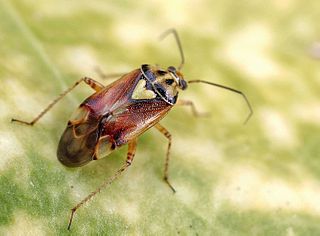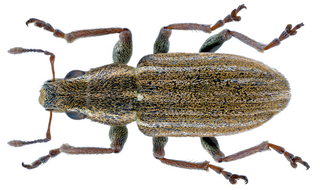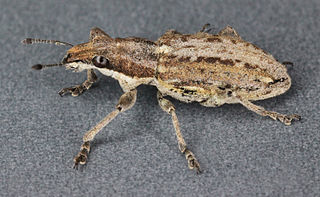
The genus Lygus includes over 40 species of plant-feeding insects in the family Miridae. The term lygus bug is used for any member of genus Lygus.
Eype Mouth is a natural break in a line of sea cliffs on the Jurassic Coast World Heritage Site in west Dorset on the south coast of England. The small River Eype drains into the sea at this point. Eype means 'a steep place' in Old English. The village of Eype lies just upstream of the rivermouth, which is reached by a single narrow lane which runs down through Lower Eype to a shingle beach with car park.

Sitona is a large genus of weevils in the family Curculionidae native to the Nearctic and Palaearctic regions. Over 100 species have been described. Sitona is easily distinguished from related genera by flat, recumbent scales on the mandibles, by the absence of an oval scar on the mandibles, by short and broad rostrum with a deep, longitudinal, median groove, and by dense scales on the body.

The Entiminae are a large subfamily in the weevil family Curculionidae, containing most of the short-nosed weevils, including such genera as Entimus, Otiorhynchus, Phyllobius, Sitona, and Pachyrrhynchus. In comparison with their stunning diversity, only a few of these weevils are notorious pests of major economic importance. Entimines are commonly encountered in the field, including urban environments, and abundant in entomological collections.
Odontostomus is a genus of air-breathing land snail, a terrestrial pulmonate gastropod mollusk in the family Odontostomidae.

Sitona lepidus or clover root weevil is a species of weevil found in Europe. It has now spread to North America and New Zealand.

Platynectes is a genus of beetles in the family Dytiscidae, containing the following species:
Sitona californicus is a species of weevil in the family Curculionidae first described by Carl Gustaf Emil Mannerheim in 1843. It can be found in the Nearctic and in US states such as Arizona and California. In California the species were recorded between March 5, 1925, and February 1, 1926, at Monterey County, Carmel while in Arizona it was found in Pima County in the Santa Rita Mountains.

Lygus gemellatus is a species of plant-feeding insects in the family Miridae.

Sitona lineatus, commonly known as the pea leaf weevil is a species of weevil with a Palearctic distribution. It is a common pest of beans, peas, and other plants in the family Fabaceae. Adult beetles of S. lineatus measure 3.4-5.3 mm in length. They are characterized by a series of colored scales arranged in alternating lines (striae) on the elytra; it is from this characteristic where the species gets its name lineatus meaning 'lined' or 'striped'. The head and pronotum also have fine pointed setae amongst the scales. The antennae are clubbed, pointed and preceded by 7 segments. The femora is dark, but tibiae and tarsi are red. As a member of Order Coleoptera (beetles) their forewings are modified to form hardened covers over the thorax and abdomen, with the hindwings for flight underneath.

Sitona sulcifrons is a species of weevil native to Europe.

Sitona striatellus is a species of weevil native to Europe.

Sitona hispidulus is a species of weevil native to Europe. Invasive to Asia and North America.

Sitona griseus is a species of weevil native to Europe.
Sitona californius is a species of broad-nosed weevil in the beetle family Curculionidae. It is found in North America.

Sitona cylindricollis, the sweetclover weevil, is a species of broad-nosed weevil in the beetle family Curculionidae. It is found in North America.
Sitona lineellus, the alfalfa curculio, is a species of broad-nosed weevil in the beetle family Curculionidae. It is found in North America.











